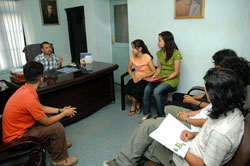|
|
| EAGER TO FLY: Students seek academic counselling at an education centre in Kathmandu |
It's been over a year since Abhisek Thapa, 24, finished his BA in Arts in political science from Calcutta. Abhisek now plans to get a postgraduate degree from Australia.
"It is not just the education. Foreign cultures and their ways of life are something I've long wanted to explore," he says, "my first choice was the US but the application and immigration procedures were much more complicated."
Instability at home, lack of job opportunities, an uncertain future and dreams of a better life are driving more Nepali students to North America, Europe, Southeast Asia and even Cyprus. Although the US remains popular, complex admission procedures, standardised tests and the huge cost of getting a US degree are driving more and more Nepali students to opt for other countries.
A prospective student could always deal with a university directly but not knowing where and how to start draws them to the 300 or so consulting firms in the capital with names like Interface, Unisearch, Universal, Orbit and PAC Asia Services.
"Students who wish to go abroad for further studies get a reality check when they start applying for a visa. Our job is simply to make the process easier by helping them choose a university, advising them on the necessary documents and forwarding them to the visa consular section," says Subash Gauchan of PAC Asia which says it sends 200 students a year to Australia, New Zealand, Canada and the Philippines.
Most students pay their own way, at least for the first year, sometimes as much as Rs 1 million that includes tuition, airfare, exam charges and living expenses. While there are more scholarships and loans available in US schools other countries let students earn by working part-time. The 20 hours per week permitted in Australia is an incentive for many like Abhisek to go down under. "My parents will be sponsoring the first two semesters and then I am on my own," he says with a hint of hope. In Australia the minimum hourly wage is AUS $16, while Canada offers 15 working hours for a minimum CDN $ 11 an hour.
 This is a relief to parents and also reduces the amount of money that goes out of the country year to pay for Nepalis studying abroad. "I understand the concern that money is going out of the country but the majority of them finish their education, get jobs and send money back which is much more than their initial expenses," says Uddab Khadka of Mentor Institute, which places students in Singapore, Ireland and Denmark.
This is a relief to parents and also reduces the amount of money that goes out of the country year to pay for Nepalis studying abroad. "I understand the concern that money is going out of the country but the majority of them finish their education, get jobs and send money back which is much more than their initial expenses," says Uddab Khadka of Mentor Institute, which places students in Singapore, Ireland and Denmark.
Universal's Uttam Panta is a little more sceptical. " It may be true that those who do well academically repatriate sizeable sums," he says, " but most others don't remit much." At least one expert believes that the trend of Nepalis venturing abroad to study will not stop soon. "You cannot blame students or their parents for being sceptical about the quality of education in Nepal," says Dilli Ram Dahal, professor of sociology and anthropology at Tribhuban University.
Dahal adds that the real issue is creating opportunities for Nepalis studying abroad to apply their skills back at home. He says: "If their skills are not being used in Nepal, we have to admit that we have been a total failure."
Rs 10 billion a year
There is no way currently to keep count of exactly how many Nepalis are studying abroad. The Ministry of Education estimates that up to 12,000 go abroad annually, excluding to India. About 40 students come to the ministry every day for recommendation letters for visas. According to the Institute of International Education, a US-based organisation that monitors international students, 4,861 Nepalis were studying in US universities and colleges in 2004-2005. International students deliver $13.3 billion to the US every year. Our estimates show that, India aside, Nepali students take out Rs 10 billion a year out of the country in hard currency to pay for their studies.
Comment at http://nepalitimes.blogspot.com



